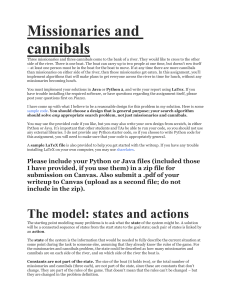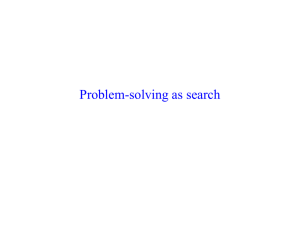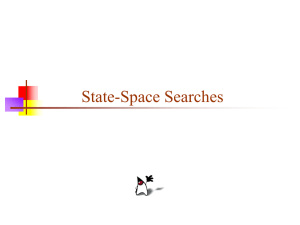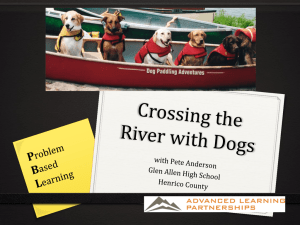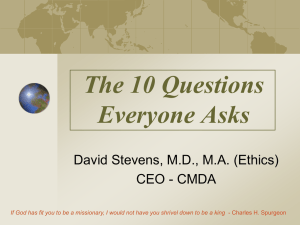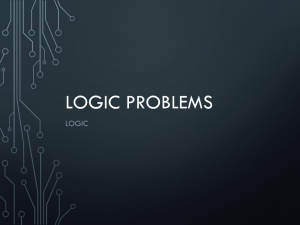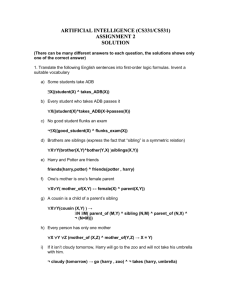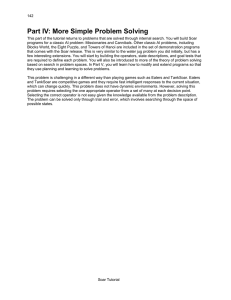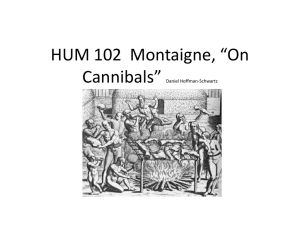Searching and AI
advertisement
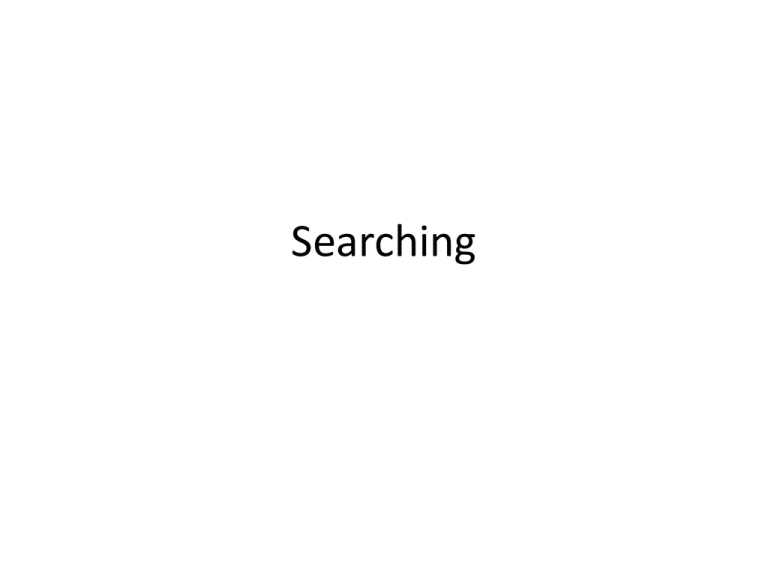
Searching Introduction to problem solving • What is problem solving? • The activities that we usually consider to require intelligence are those that call for thinking and reasoning– for example, solving problems, proving theorems and playing games (e.g. chess) • To solve a problem is to find a solution, or in some cases the best solution, to it. 2 Example • Consider walking from IFM, Shaaban Robert street to Mlimani City shopping centre… • Each location could be considered a knowledge state, and these knowledge states are linked by the actions performed at each of them (going straight on, turning left etc.) 3 Example • The route we are describing, drawn on a map of Dar es Salaam, is a path from state to state – starting with starting point (start state) – to the finishing point (goal state). • What we are doing is constructing a path through Dar es Salaam to satisfy the need to get to Mlimani City SC Problem space theory • Such problems are described by problem space theory • We construct a path through the problem space (possible location points in our example) to satisfy the need identified in the goal. • Assuming that we do not have complete knowledge of the problem area, we are trying to construct a path between the problem and the solution. 5 Adversary and non-adversary problems • An adversary problem is one in which two or more people compete against each other. – E.g. chess. • Non-adversary problems are ones that do not involve another person (except in the role of problem setter). – E.g. puzzle, crossword. 6 Game playing • Game playing is a special sort of problem solving in which the problem is to find a winning strategy or to find the best current move. • Successful strategies in AI research on game playing for games with two players, in which – each player always has complete information about the state of play – there is no element of chance. • Examples – Noughts and crosses, chess • Games with incomplete information 7 Non-adversary problems • The 8-puzzle - a 3 x 3 square containing the numbers 1 to 8 which must be moved via the vacant square until they are in order. 4 2 7 5 6 3 1 2 3 1 4 5 6 8 7 8 8 Non-adversary problems • Cannibals and missionaries – Transport three Cannibals and three Missionaries across a river in a boat that can only hold two people, but that needs at least one to get it across the river. – Cannibals must never outnumber Missionaries on either bank, or the Missionaries will be eaten. • Jugs problems – Three jugs, A, B and C can hold 8, 5 and 3 liters respectively. – A is full; B and C are empty. – Find a sequence of pourings that leaves 4 liters in A and 4 liters in B. 9 Non-adversary problems • The towers of Hanoi (Edouard Lucas, 1883) – Three vertical pegs with four (or more) discs of decreasing size piled on one peg. – Transfer the discs to the second peg, moving only one disc at a time, and never placing a larger disc on top of a smaller one. A C B 10 The search problem • We’ll consider a problem soluble by searching if – the problem can be formulated in terms of a progression of states from some initial state to some target (or goal) state. – this progression can be enumerated through the application of some given set of actions (or operators). • these actions define some transformation of all, or part, of the state. • In problems, such as Cannibals and Missionaries or the Towers of Hanoi, all three are clearly specified – AI programs are relatively successful at solving these problems 11 Search problem • In AI there are two main approaches to describing the search for solutions to problems: – problem-reduction representations • operators that divide goals into sub-goals – state space representations • operators that change one state of the world into another 12 Problem reduction representation • In a problem reduction representation each operator divides one goal into a set of subgoals that are easier to achieve. • Problem reduction depends on the fact that some sub-goals are so simple that they can be satisfied directly. • The aim of problem reduction is to analyse the main goal into components of this sort. 13 Towers of Hanoi A B C • The overall goal is to move the four discs from A to B, moving only one disc at a time, never placing a larger disc on top of a smaller one. • This goal can be divided into three sub-goals: – Transfer the three smaller discs from A to C. – Transfer the largest disc from A to B. – Transfer the three smaller discs from C to B. • Of these goals, (1) and (3) can be reduced further, while (2) can be achieved directly, provided that (1) has been achieved. 14 State space representation • The basic component of a state space representation is a state of the world or, rather, a state of that small part of the world that is relevant to the problem. • For example, in the Missionaries and Cannibals problem a typical state of the world might be: Left Bank 2 Missionaries 2 Cannibals Boat Right Bank 1 Missionary 1 Cannibal • The states of the world are linked by operators that can change one state into another. 15 Operators • A solution to a problem is a sequence of operators that provides a path between the initial state and (one of) the goal state(s). • To find a solution, the operators must be applied to the initial state and/or the goal state according to a set of rules (or search strategy), until a path between those two states is discovered. 16 Applying the operators • For example, the operator ‘Take one Missionary and one Cannibal from the Left Bank to the Right Bank in the boat’ results in the following new state: Left Bank 2 Missionaries 2 Cannibals Boat Right Bank Left Bank 1 Missionary 1 Missionary Right Bank 1 Missionary 2 Missionaries 1 Cannibal 2 Cannibals Boat • From each state it is (usually) possible to reach several others by applying different operators. 17 State spaces • A map of all states that can be reached from the initial state by the application of one or more operators is called a state space. • State spaces can be represented by tree diagrams, with the initial state at the top, and paths to other states branching beneath it. 18 State spaces • For many problems such tree diagrams can be extended indefinitely. • Solutions to a problem, if there are any, are represented by paths through the tree from the initial state to (one of) the goal state(s). Tree representation • In a tree representation the same state will appear more than once if it can be reached in several ways from the initial state. 20 Tree representation • It is sometimes useful to use state space representations in which all occurrences of the same state are collapsed (overlapped). – Such representations are graphs rather than trees. – Graph theory • Every problem has a different search space • We want a general solution that may be applied to any search space. • We need an abstract formal framework for constructing and analysing search spaces. Graph terminology • A graph is defined as a set of nodes, with links between them (also called vertices and edges). • Links may be directed (denoted by arrows) or undirected. • A path is a sequence of nodes that connects two nodes via links. 22 Graph terminology • An acyclic graph is a graph that contains no cycles (paths that link a node to itself). • The parents of a node N, are all the nodes that have links leading to N. • The children of a node N, are all the nodes that N provides a link to. Example graphs A D A D C B E E A A (labeled) graph D C E B An acyclic directed graph D B A directed graph F A F C C E B A directed graph with a cycle 24 Tree terminology • A tree is a graph where each node has at most one parent. • Trees are always directed. • The root node of a tree is the only node that has no parent (each tree has a root) • For any node N, all the other nodes that have the same parent as N are called siblings of N. • For a node N, all the nodes whose paths pass through N (but not N itself) are considered descendents of N. 25 A route-finding example School Factory Hospital Newsagent Church Library Park University • Suppose we want to find the route from the Library (L) to the University (U). 26 Search space • We can represent the town map more abstractly L (Library) S (School) F (Factory) H (Hospital) P (Park) N (Newsagent) U (University) C (Church) Do you see a problem with this tree? 27 – Each state is a location – The only action is to drive from one location to another. – The initial state (L) is used as the root of the tree, and referred to as the start node. – Now, rather than talking about a route from the library to the university, we can talk about finding a path from the start node (L) to the goal state - here node (U). Missionaries and cannibals Key: M = Missionary C = Cannibal * = Boat LB = Left bank RB = Right bank LB: RB: Boat: LB: RB: MMMCCC* Boat: MC LB: RB: MMCC MC* Boat: LB: RB: C MMMCC* C 28 CC MMMC CC* Boat: CC LB: RB: MMMCCC* Well-defined problems • A problem can be formally defined by – The initial state – Possible actions (operators) – Goal test – to determine if a given state is a goal • Explicit list of goal states • Property of the goal state (‘chess’) – Path cost – assigns a numeric cost to each path • A solution to a problem is a path from the initial state to a goal state. 29 Search nodes ≠ States 8 2 3 4 7 5 1 6 8 2 7 3 4 5 1 6 8 2 3 4 7 8 2 3 4 7 8 4 3 2 7 5 1 5 1 5 1 6 6 6 8 2 3 4 7 5 1 If states are allowed to be revisited, the search tree may be infinite even when the state space is finite 30 6 Uninformed vs. informed search • Uninformed (blind) search – no information about the number of steps or the path cost from the current state to the goal — all they can do is distinguishing a goal state from a non-goal state • Informed search (or heuristic search) – use information (heuristics) guesses about the search space 31 Measuring performance • Completeness – Is the algorithm guaranteed to find a solution when there is one? • Optimality – Does the strategy find the optimal (highestquality) solution when there are several different solutions? 32 Measuring performance • Time complexity – How long does it take to find a solution? • Space complexity – How much memory does it need to perform the search?
